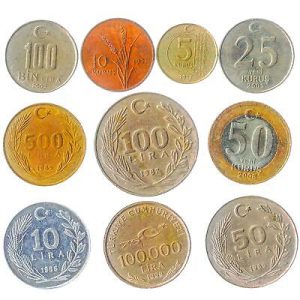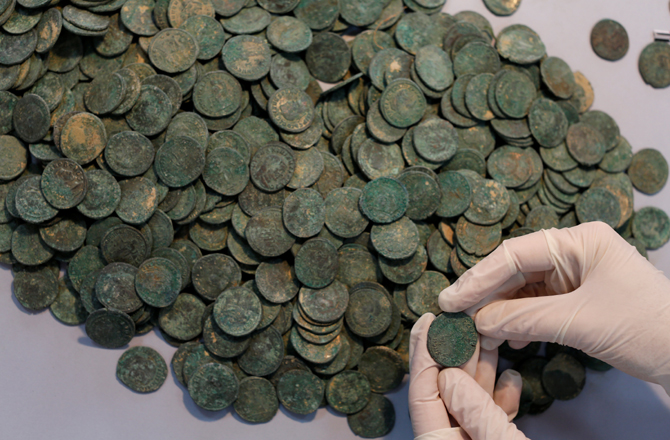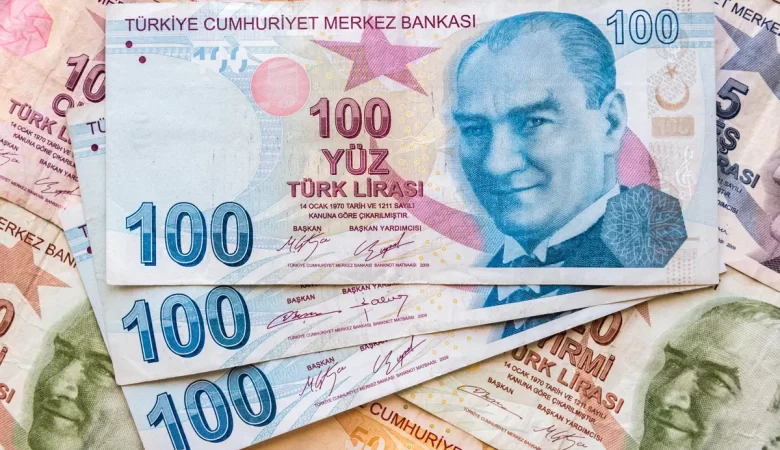The territory of modern Turkey for centuries – from the fall of Byzantium to the beginning of the 20th century – was the central part of the vast Ottoman Empire, which at the peak of its power included the territories of such modern countries as Greece, Bulgaria, Syria.
Israel, Iraq, Egypt, etc. However, this empire was gradually losing territory, and soon after losing the First World War, it was almost completely divided between different countries. In 1919-1923. national-patriotic forces led by Mustafa Kemal managed to return part of the lost territories and created the Turkish Republic within its current borders.
From the Ottoman Empire, the new young republic inherited an almost non-archaic monetary system reformed in 1844. The monetary unit was the lira¹, which consisted of 100 kurushes². Each kurush, in turn, was divided into 40 pairs (that is, a coin of 10 pairs is not a tenth, but a quarter of kurush). Coins were minted not only from copper, silver and gold, but also from an advanced material for those times – nickel.
All coins retain the strict design characteristic of Islamic countries: inscriptions in Arabic script, ornaments, but no images of people, animals or even buildings. The main element of the decor is the tughra – the personal sign of the Sultan, containing his name and title and made in a special calligraphic style. The denominations of small coins made of base metals are made in large, clearly visible numbers. On silver and gold coins, the denomination, if it was signed, is very small and imperceptible.

But the most difficult thing is to determine not the denomination, but the date of issue of Ottoman coins. The reverse of the coin indicated the year of the accession of the Sultan to the throne (for example, 1327 Hijri for Mehmed V). On the obverse of the coin under the tughra.
the year of minting the coin was indicated, counted from the year of accession to the throne (for example, 9 years). That is, to calculate the calendar year of minting, it is necessary to add the number indicated on the obverse to the number indicated on the reverse, and then subtract one, because the first year of reign was also taken into account. We get: 1327 + 9 – 1 = 1335 Hijri.
Further, when translating this date into the date of the Gregorian calendar familiar to us, it must be remembered that the Hijri years are shorter than the Gregorian ones by 10-12 days. Because of this, their start and end times are constantly shifting. Usually, with rare exceptions.
each year of the Hijri corresponds to two different Gregorian years: part of the year of the Hijri falls at the end of one Gregorian year, and part at the beginning of another. In particular, the year 1335 Hijri began on October 27, 1916, and ended on October 16, 1917. Thus, the Ottoman coin with the date “1327 // 9” was most likely minted in 1917 AD. Although, perhaps, in 1916.
Atatürk’s reforms, transitional types of coins
The collapse of the Ottoman Empire led to the fact that radical changes in literally all elements of the state and social structure became possible. And the successes of Mustafa Kemal in returning part of the lost territories to Turkey gave him an unlimited mandate to carry out any reforms.
And indeed, the scale of the transformations he carried out is amazing: the establishment of a republican system on the site of a centuries-old monarchy, secularization, the granting of rights to women, the transition to a European style of dress, calendar reform, the introduction of surnames, the translation of the Turkish language from Arabic to Latin alphabet, etc.
Of course, the reforms also affected cash circulation, where several stages of transformation can be distinguished.
At first, coins were issued with inscriptions in Arabic script, but the dates were indicated not according to the Islamic calendar from the Hijra, but according to the Rumian (“Roman”) calendar, which was used in the Ottoman Empire in parallel with the Islamic since 1839, but so far it has never been hit the coins. The Rumian calendar years are different from the Hijri years. In addition.

previously unseen design elements appeared in the design of the coins: a significant part of the area of the coin began to be occupied by an oak branch and an ear of bread. The denominations were designated as 100 pairs, 5 kurush and 10 kurush. The number “100” should not be misleading: this is not the largest, but the smallest coin of the three. Since there were 40 pairs in 1 kurush, 100 pairs meant 2.5 kurush.
These coins were issued in 1340 and 1341 Rumian years (corresponding exactly to 1924 and 1925 AD), after which the date was changed to the Gregorian one. Similar three types of coins appear with the dates 1926-1928, but the dates continued to be written in Eastern Arabic numerals. Also during these years, 25 nickel kurush and gold investment kurush 25, 100, 250 and 500 kurush were issued.
At the next stage of the reforms, a coin of 100 kurushes of 1934 was issued with a design that was completely unimaginable for the former Ottoman Empire: a portrait of a man was placed on its obverse. Of course, this man was Mustafa Kemal himself. Moreover, such a coin appeared in a Muslim country, where the ban on the image of people was strictly observed for a long time.
Another innovation that distinguishes this coin was the use of inscriptions in Latin letters and Indo-Arabic numerals familiar to Europe. Although the Latin alphabet was introduced in 1929, the first coin using it did not appear until five years later.
But what is interesting is that something remained from the old Ottoman traditions of issuing coins: the denomination was designated not as “1 lira”, but as “100 kurush”. Recall that in the Ottoman Empire, lira denominations were used only on banknotes and never on coins. In a sense, this tradition is still alive today: to this day, Turkish gold investment coins are issued with denominations in kurush, and not in lira.



